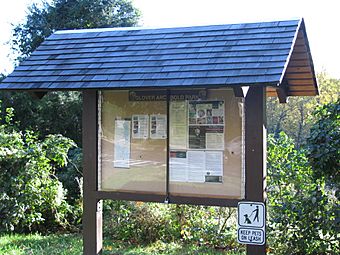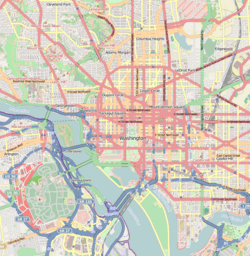Glover-Archbold Park facts for kids
|
Glover Archbold Park
|
|
 |
|
| Location | Foundry Branch, NW Washington, D.C. |
|---|---|
| Area | 221 acres (89 ha) |
| NRHP reference No. | 06001260 |
Quick facts for kids Significant dates |
|
| Added to NRHP | January 16, 2007 |
Glover Archbold Park is a large, natural park in Northwest, Washington, D.C.. It covers about 183 acres. This park is a green space in the city, located near Georgetown University and several neighborhoods.
The park follows Foundry Branch, a stream that flows from Van Ness Street down to Canal Road near the Potomac River. Smaller streams, some from natural springs, also flow into Foundry Branch. Glover Archbold Park is part of the larger Rock Creek Park system, managed by the National Park Service (NPS).
To protect the park's natural beauty, the NPS has rules:
- You cannot remove anything from the park's natural areas.
- Dogs must be on a leash.
- Bicycles and motorized vehicles are not allowed.
Many people enjoy the park for walking, hiking, and jogging. There's also a historic Victory Garden near W Street, N.W.
Contents
Park History: How It Began
Glover Archbold Park got its name from Charles Carroll Glover and Anne Mills Archbold. They generously donated the land for the park in 1924. The Glover family says their name like "glove' er." Sometimes, people mistakenly call it Glover Archibald Park.
A Highway That Was Never Built
In 1947, a senator named Carl Hayden suggested building a four-lane highway through the park. It would have been called Arizona Avenue. Luckily, this highway was never built. Instead, the path where it would have gone is now a popular trail called the Glover Archbold Trail.
Famous Visitors and Students
In 1963, a famous conservationist and writer named Rachel Carson visited the park. She came with members of the Audubon Naturalist Society. Since at least 1975, students from Georgetown University have used the park to study nature and learn about its environment.
Amazing Nature in the Park
Glover Archbold Park is home to thousands of different living things. These include tiny organisms like bacteria, as well as plants and animals.
Fungi and Trees
The park might have over 200 types of fungi, like the interesting artist's fungus and turkey-tail fungus. Many kinds of trees grow here too, such as:
- American beeches
- American elms
- Eastern sycamores
- Tuliptrees
- White oaks
Wildflowers and Insects
In spring, you can see beautiful wildflowers like spring-beauties. Other wildflowers include asters and yellow jewelweed. Be careful though, because poison-ivy is common in the park.
The park is buzzing with many insects. Some of them are:
- Black swallowtails
- Eastern tiger swallowtails
- Monarchs
- Imperial moths
- Different kinds of bees and butterflies
Animals of the Park
While some animals like bears and bison used to live in this area, they are no longer found in the park. However, you can still spot many cool creatures:
- Birds: American robins, blue jays, northern cardinals, and barred owls.
- Mammals: Common raccoons, coyotes, gray foxes, Virginia opossums, and white-tailed deer.
Challenges the Park Faces
Glover Archbold Park faces several challenges that affect its health.
Pollution and Water Issues
The park's stream, Foundry Branch, is affected by pollution from air, fertilizer, and soil. Sometimes, the park can even smell like sewage. Heavy storms cause the stream to flow very fast. This leads to erosion, which washes away soil. It also pollutes the water with runoff from roads and even raw sewage. People sometimes let their dogs drink or play in the stream, not knowing the water might be polluted.
Park Boundaries
The park is long and narrow, surrounded by houses and buildings. Some people accidentally extend their yards into the park's land. The National Park Service asks everyone to help protect the park by respecting its boundaries.


